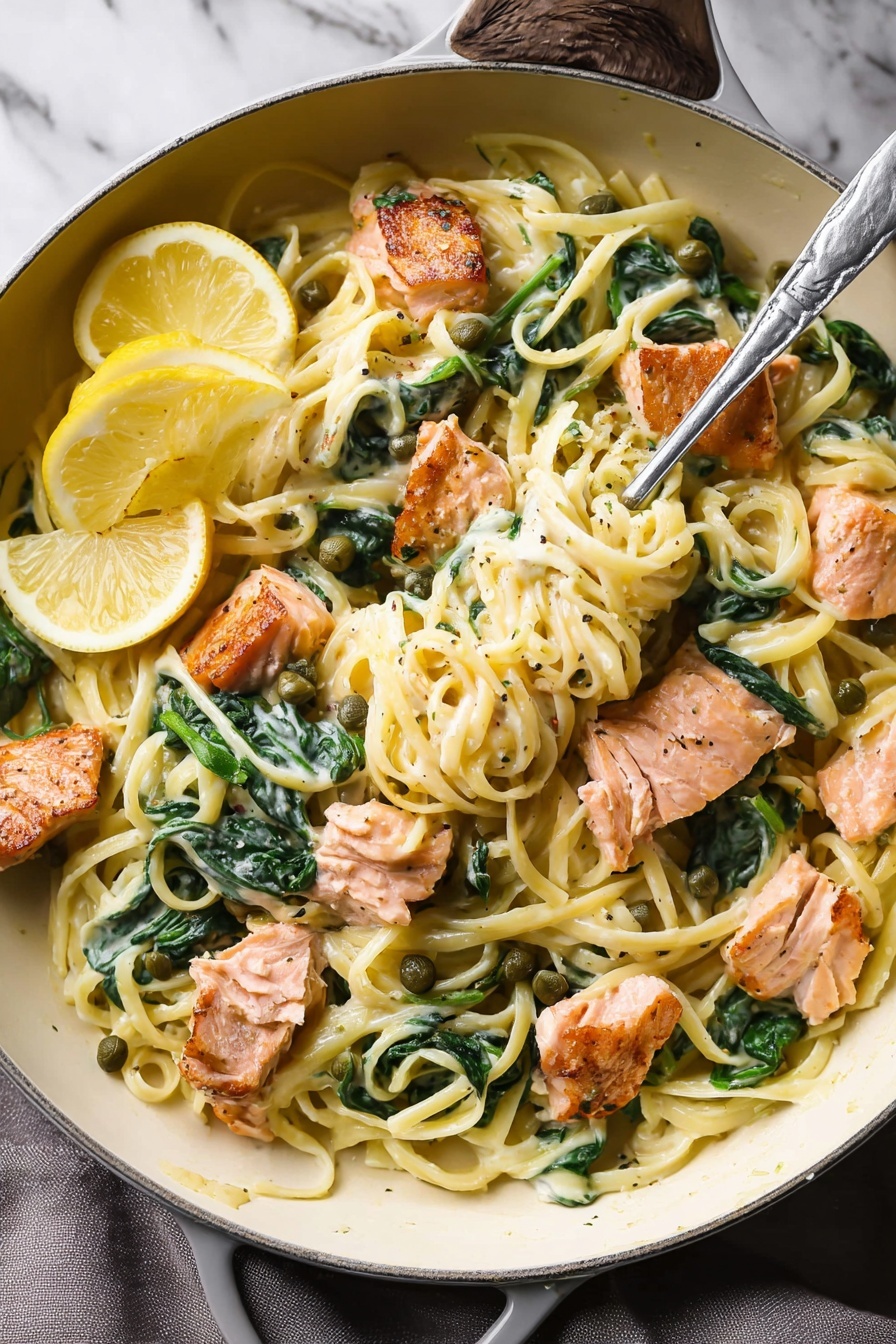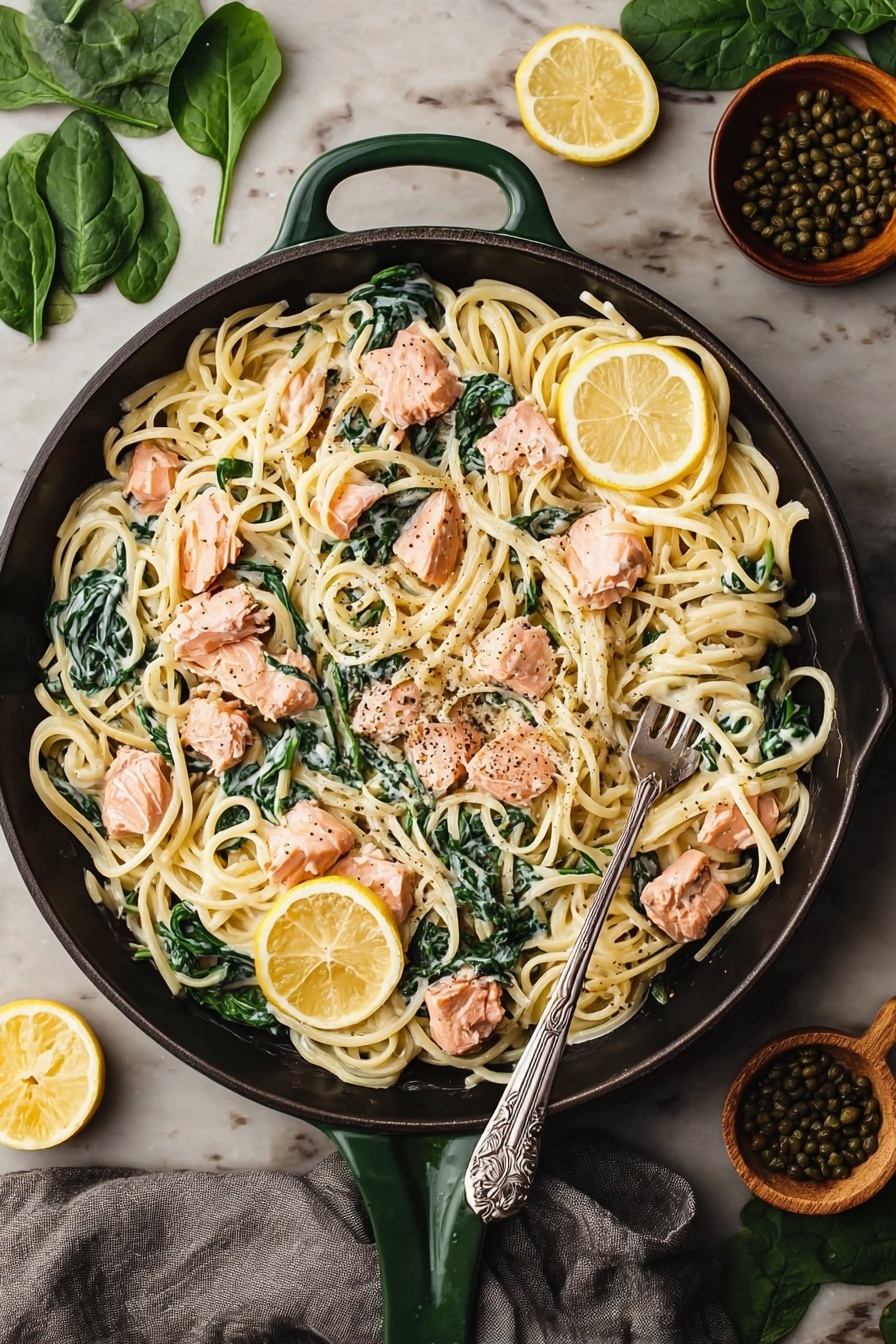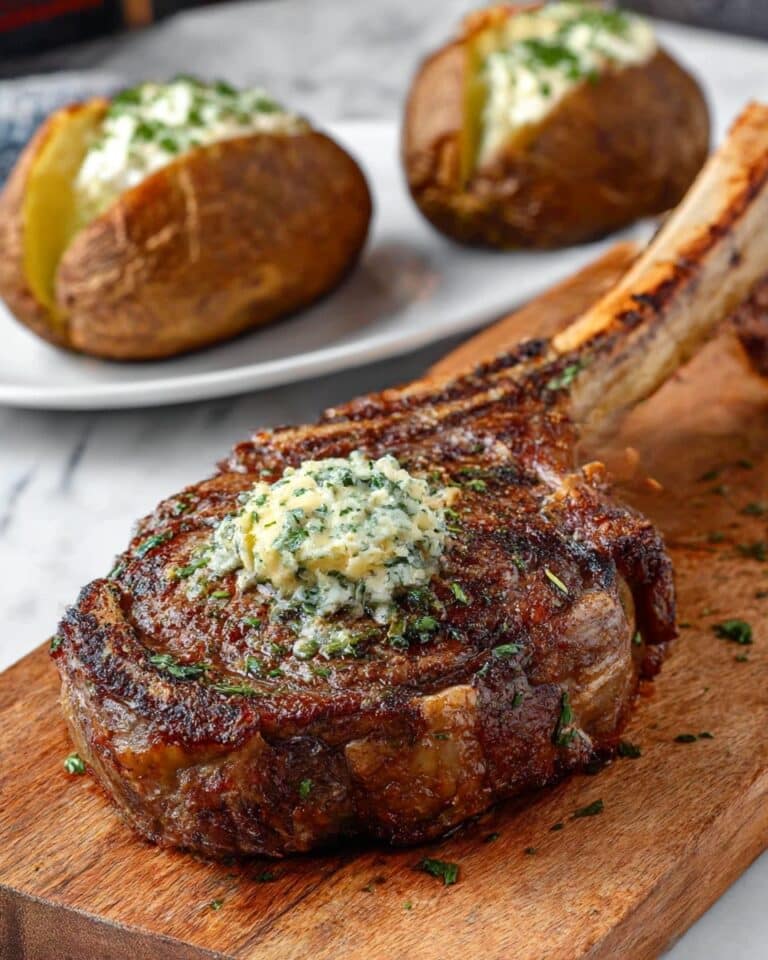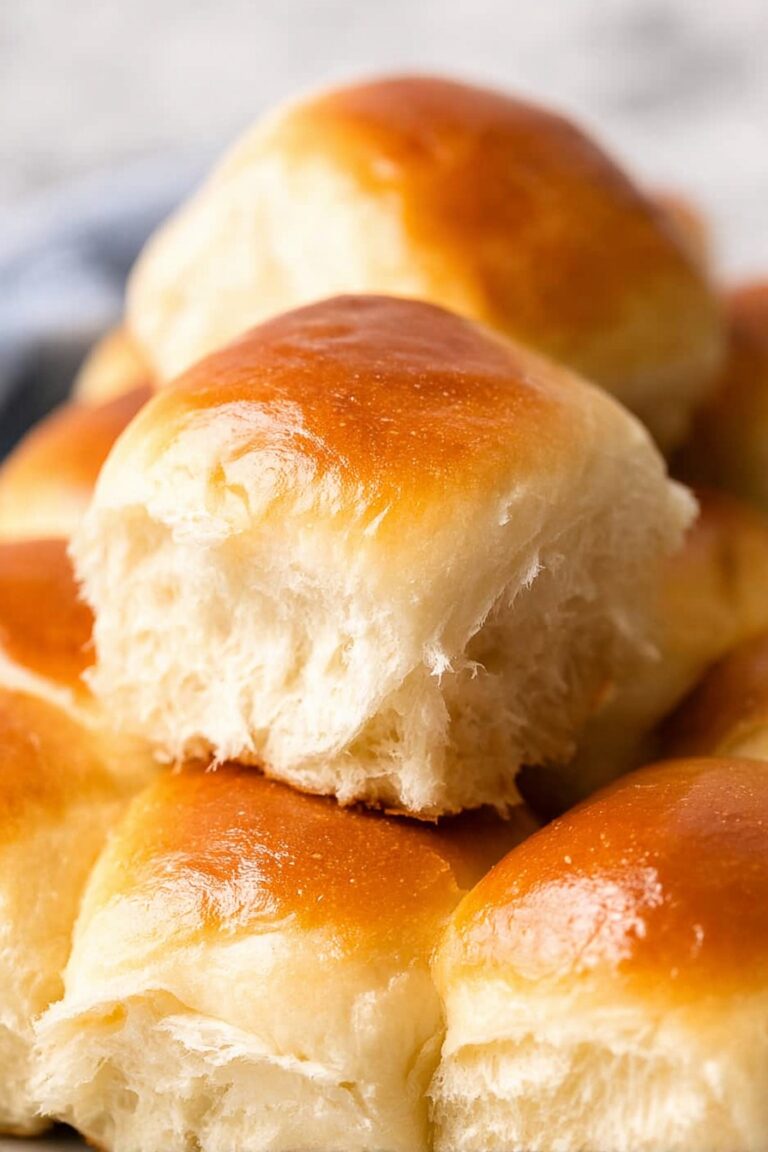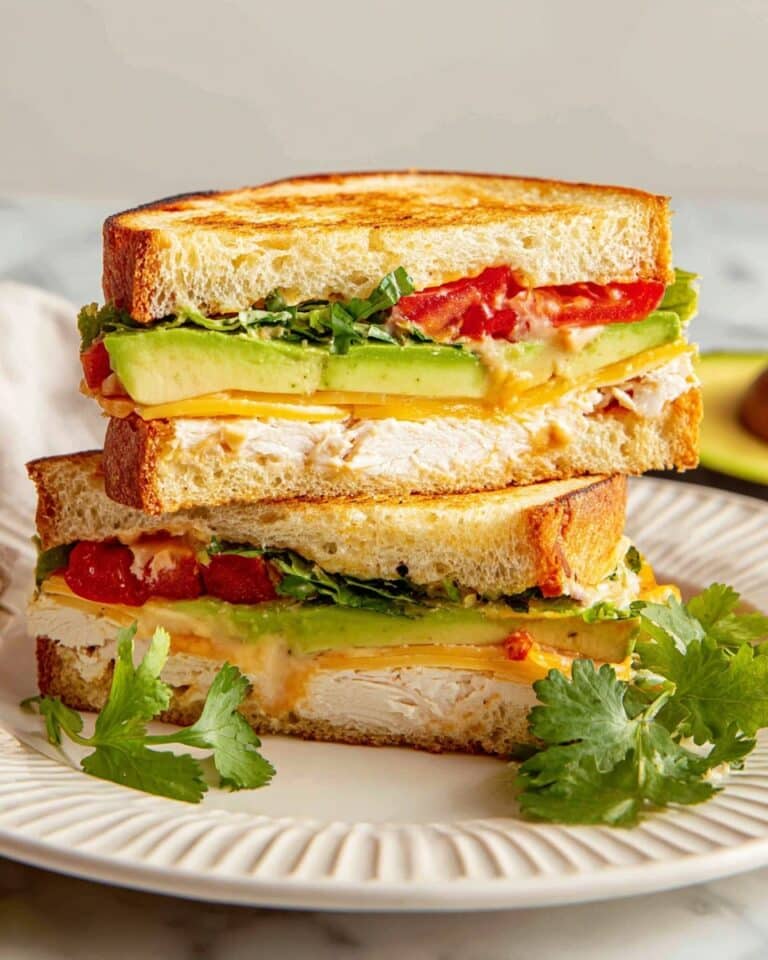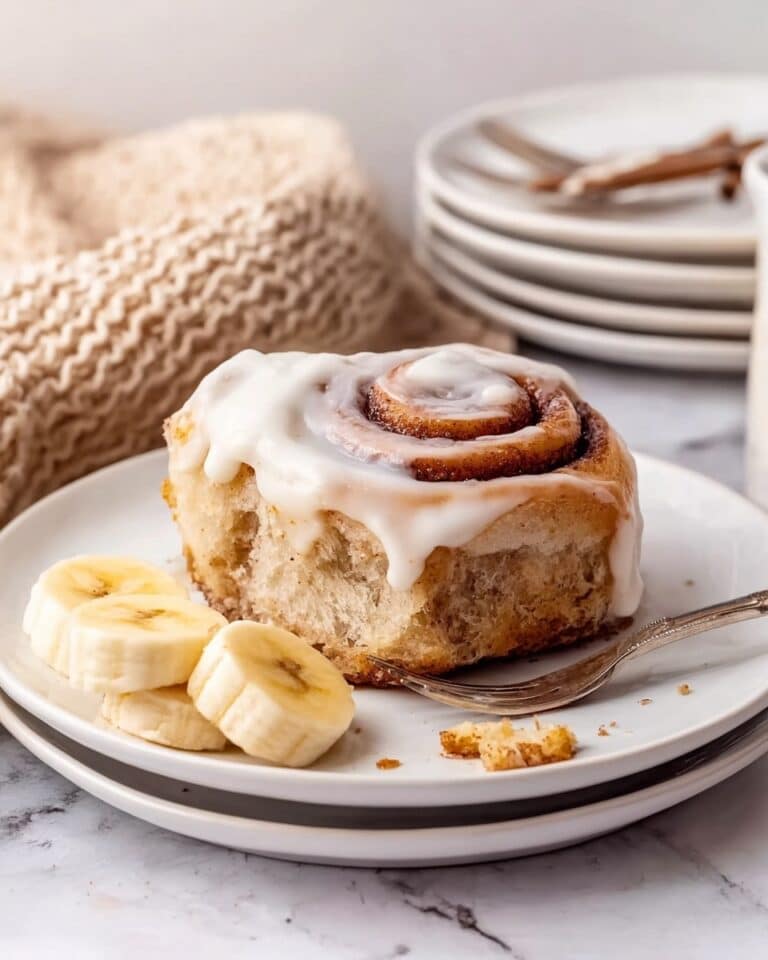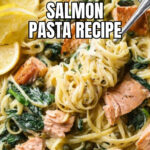Creamy Salmon Pasta Recipe
If you’re anything like me and crave a delicious, comforting meal that doesn’t feel like a weeknight chore, this Creamy Salmon Pasta Recipe will totally win you over. It’s rich, flavorful, and surprisingly easy to make—perfect for when you want to impress yourself (or your friends) with minimal fuss. Trust me, once I started making this, it quickly became one of my go-to dinners, and I know you’ll love it as much as I do.
Why This Recipe Works
- Balanced Flavors: The creamy sauce, fresh lemon zest, and briny capers create a perfect harmony with tender salmon.
- Simple Technique: Baking salmon and tossing it into a quick cream sauce saves time without sacrificing taste.
- Nutritious and Satisfying: Combining protein-packed salmon and spinach with pasta gives you a hearty, balanced meal.
- Versatile and Adaptable: This recipe is easy to tweak with what’s in your fridge or pantry.
Ingredients & Why They Work
Each element in this Creamy Salmon Pasta Recipe brings something special to the table. From the richness of heavy cream and the brightness of lemon zest to the salty pop of capers, every ingredient plays a part in creating that rich, restaurant-quality flavor at home. When you shop, try to get fresh salmon and a decent dry white wine—the quality will definitely shine through.

- Salmon fillets: Fresh or thawed, firm-fleshed salmon works best here for that flaky but juicy texture.
- Kosher salt: Enhances natural flavors; don’t skip adding salt both to the salmon and pasta water.
- Ground black pepper: Adds a subtle kick without overpowering the creaminess.
- Linguine: Holds the sauce beautifully; you can also use fettuccine or spaghetti if you prefer.
- Unsalted butter: Builds richness and helps mellow the garlic flavor in the sauce.
- Garlic cloves: Freshly minced garlic infuses the cream sauce with irresistible aroma.
- Heavy cream: The star ingredient that makes the sauce luxuriously velvety.
- Dry white wine: Adds acidity and depth—choose something you’d enjoy drinking.
- Lemon zest: Brings fresh, citrus brightness to balance the richness.
- Baby spinach: Wilts quickly and adds a healthy green touch without fuss.
- Capers: Their briny punch wakes up the dish beautifully.
- Lemon wedges: Optional but highly recommended for that final squeeze of freshness.
Make It Your Way
I love that this Creamy Salmon Pasta Recipe feels fancy but is so easy to personalize. I often mix up the greens or add different herbs, and sometimes swap the white wine for chicken broth if I’m out. Feel free to make this dish your own—it’s a flexible canvas for your creativity.
- Variation: I sometimes toss in sun-dried tomatoes or fresh dill for an extra burst of flavor that pairs beautifully with salmon.
- Dietary tweak: Use gluten-free pasta if you need to keep it gluten-free; it won’t change the creamy goodness at all.
- Seasonal changes: Swap spinach for kale or arugula depending on what’s fresh and in season for a slightly different texture.
Step-by-Step: How I Make Creamy Salmon Pasta Recipe
Step 1: Prep and Bake the Salmon
First things first: preheat your oven to 350°F. Spray a small rimmed baking dish with nonstick spray, then place your salmon fillets skin-side down. I sprinkle them with half the kosher salt and black pepper—this little seasoning step is crucial, trust me. Bake the salmon for about 14 to 16 minutes, just until it’s almost opaque and reaches 145°F inside. Don’t skip the internal temperature check if you have a thermometer; it ensures perfectly cooked salmon every time without drying it out.
Step 2: Cook the Pasta
While the salmon is working its magic in the oven, bring a large pot of salted water to a boil. The salt seasons the pasta from within, so don’t be shy here. Cook your linguine according to the package, aiming for al dente—it should still have a little bite because it will keep cooking a bit more when mixed with the sauce. Drain and set aside.
Step 3: Create the Creamy Sauce
In a large pan, melt butter over medium heat. Toss in the minced garlic and cook it for just about a minute while stirring constantly—watch carefully so it doesn’t brown and turn bitter. Then add your heavy cream, white wine, lemon zest, and the remaining salt and pepper. Bring this mixture to a gentle boil over medium-high, then reduce heat and let it simmer for 5 to 6 minutes. You’re aiming for a sauce that’s thickened just enough to coat the pasta but still lovely and pourable. Stir frequently here to keep it smooth and prevent sticking.
Step 4: Wilt the Spinach, Add Pasta, and Toss
Lower the heat to medium-low and add the baby spinach and capers to your sauce. The spinach will quickly wilt—no more than a couple minutes—and the capers add that gorgeous salty pop. Toss in your drained linguine right on top so it can soak up all those flavors. Stir everything gently but thoroughly, letting the spinach finish wilting with the heat.
Step 5: Finish with Salmon and Serve
Pull the salmon out of the oven. Carefully slide a spatula between the skin and the flesh to remove the skin; I’ve found this little trick makes the salmon easier to break into perfect chunks that meld beautifully with the pasta. Toss those big salmon pieces gently into your skillet with the linguine and sauce. Give everything one last gentle mix and serve immediately—with lemon wedges on the side for that optional bright finish.
Tips from My Kitchen
- Don’t Overcook Salmon: Keep an eye on the time or better yet, use a meat thermometer to avoid dry salmon—145°F is perfect.
- Simmer Sauce Gently: High heat can cause cream to separate; patience with medium-low heat keeps it silky.
- Reserve Pasta Water: If your sauce seems too thick, a splash of pasta water helps loosen it and binds the sauce to the noodles.
- Use Fresh Lemon Zest: Fresh zest brightens the whole dish more than bottled lemon extract ever could.
How to Serve Creamy Salmon Pasta Recipe
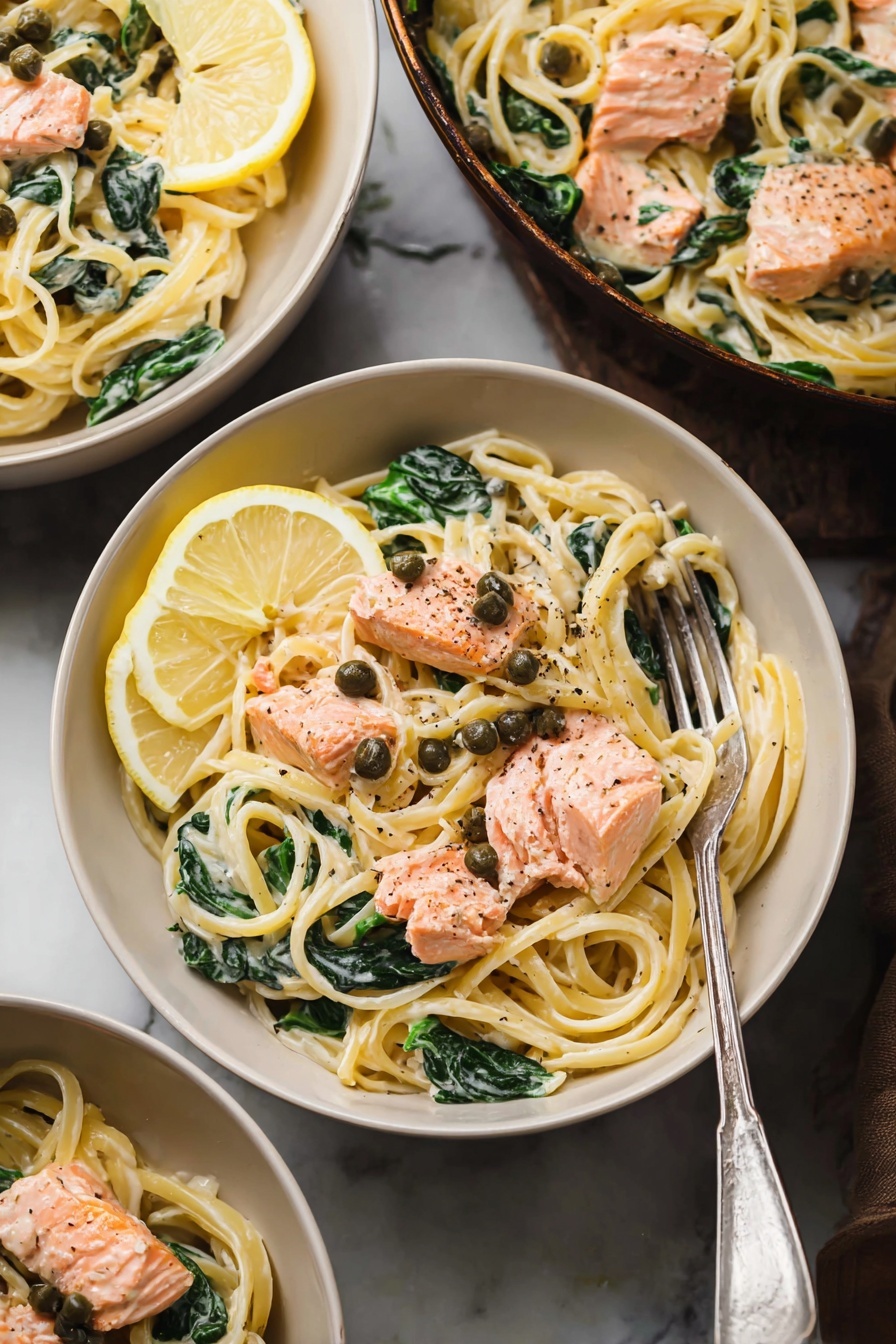
Garnishes
I almost always serve this pasta with fresh lemon wedges for squeezing over the top—it adds a zesty pop that cuts through the richness perfectly. Fresh chopped parsley or dill sprinkled right before serving also brings a lovely herbal note. If you want a bit of crunch, some toasted pine nuts work beautifully, too.
Side Dishes
My favorite sides to go with this creamy salmon pasta are simple: a crisp green salad with a light vinaigrette or roasted asparagus tossed with lemon and garlic. Either keeps the meal balanced and fresh without overshadowing that creamy goodness in your bowl.
Creative Ways to Present
For special dinners, I like to plate the pasta in a shallow bowl, topping it with a salmon chunk standing tall and a little extra drizzle of sauce. A sprinkle of microgreens or edible flowers makes it look super elegant without extra effort. Trust me, your guests will think you spent all day!
Make Ahead and Storage
Storing Leftovers
I store leftover creamy salmon pasta in an airtight container in the fridge, and it usually stays good for about 2 days. Because of the cream, I avoid keeping it too long, but honestly, there’s rarely much left!
Freezing
This one’s a bit tricky for freezing because cream sauces can separate. I’ve tried it once, and while it’s edible, the texture changes. I’d recommend enjoying this dish fresh or refrigerated rather than frozen.
Reheating
When reheating, I gently warm leftovers on the stove over low heat, adding a splash of milk or cream to bring back some saucy silkiness. Microwave reheating works too, just be sure to stir occasionally and avoid overheating to keep the salmon tender.
FAQs
-
Can I use frozen salmon in this Creamy Salmon Pasta Recipe?
Absolutely! Just make sure to thaw the salmon fully in the fridge before cooking to ensure even baking and to avoid a soggy texture. Fresh is ideal, but thawed frozen salmon works well if prepped properly.
-
What if I don’t have white wine on hand?
No worries! You can substitute dry white wine with low-sodium chicken or vegetable broth. It won’t have the same acidity, but it will still keep the sauce flavorful. Add a little extra lemon zest to brighten it up.
-
How do I know when the sauce is thick enough?
Look for a consistency that lightly coats the back of a spoon—when you run your finger through it, the line should stay clear without the sauce running back immediately. It should be pourable but cling to your pasta.
-
Can I use a different pasta shape?
Of course! Linguine works beautifully, but fettuccine, spaghetti, or even penne can be delicious alternatives. Just adjust cooking time according to the package directions for the best texture.
-
Is this recipe suitable for weeknight dinners?
Definitely! It only takes about 40 minutes total and uses straightforward steps, making it a perfect option for a fast but impressive weeknight meal.
Final Thoughts
This Creamy Salmon Pasta Recipe holds a special place in my heart whenever I’m craving something satisfying but not complicated. It’s a dish I’m proud to serve, whether for a casual weeknight or a small dinner gathering. I love how effortlessly it comes together, and I hope you’ll find the same joy making and sharing it. Give it a try—you just might have a new favorite on your hands!
Print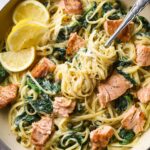
Creamy Salmon Pasta Recipe
- Prep Time: 15 minutes
- Cook Time: 25 minutes
- Total Time: 40 minutes
- Yield: 4 servings
- Category: Main Course
- Method: Baking
- Cuisine: Italian-American
Description
A rich and creamy salmon pasta recipe featuring baked salmon, tender linguine, and a luscious sauce made with heavy cream, white wine, garlic, and spinach. This comforting dish is perfect for a satisfying dinner and garnished with capers and lemon wedges for a bright finish.
Ingredients
Salmon
- 2 salmon fillets about 3/4 pound
- 1/2 teaspoon kosher salt
- 1/4 teaspoon ground black pepper
- Nonstick cooking spray
Pasta
- 12 ounces linguine
- Salt for pasta water (large pinch)
Sauce and Additional Ingredients
- 2 tablespoons unsalted butter
- 3 garlic cloves minced
- 1 1/4 cups heavy cream
- 1/2 cup dry white wine
- 1 teaspoon grated lemon zest
- 1 box baby spinach 5 ounces
- 2 tablespoons capers
- 1/2 teaspoon kosher salt
- 1/4 teaspoon ground black pepper
- Lemon wedges for garnish (optional)
Instructions
- Prepare Oven and Salmon: Preheat the oven to 350 degrees F. Spray a small rimmed baking pan with nonstick cooking spray. Place the salmon fillets skin side down on the prepared pan, then sprinkle with 1/2 teaspoon salt and 1/4 teaspoon black pepper. Bake for 14 to 16 minutes until the salmon is almost opaque and reaches an internal temperature of 145 degrees F.
- Cook Pasta: Meanwhile, bring a large pot of water to a boil with a large pinch of salt. Cook the linguine according to the package instructions until al dente. Drain and set aside.
- Make the Sauce: While the pasta cooks, melt butter in a large high-sided skillet over medium heat. Add the minced garlic and sauté for 1 minute, stirring constantly to avoid burning. Add the heavy cream, white wine, lemon zest, remaining 1/2 teaspoon salt, and 1/4 teaspoon pepper. Bring the mixture to a boil over medium-high heat, then reduce to medium and cook for 5 to 6 minutes until the sauce thickens to a thin consistency, stirring frequently. Reduce heat to low.
- Combine Pasta and Spinach: Add the spinach and capers to the skillet with the sauce. Add the drained linguine on top and cook over low heat for 1 to 2 minutes, tossing frequently until the spinach is just wilted.
- Finish with Salmon: Remove the salmon from the oven. Use a spatula to carefully separate and discard the skin. Break the salmon into large chunks and add it over the pasta in the skillet. Gently toss to combine.
- Serve: Serve the creamy salmon pasta garnished with lemon wedges for squeezing over the dish, if desired.
Notes
- Use a white wine that is dry and good for cooking, such as Sauvignon Blanc or Pinot Grigio.
- To save time, salmon fillets can be substituted with pre-cooked salmon, but fresh baked salmon provides the best flavor.
- If you prefer a lighter sauce, substitute half and half for heavy cream.
- For added texture, sprinkle freshly grated Parmesan before serving.
- Ensure not to overcook the salmon to keep it moist and tender.
Nutrition
- Serving Size: 1 serving
- Calories: 650 kcal
- Sugar: 3 g
- Sodium: 750 mg
- Fat: 40 g
- Saturated Fat: 20 g
- Unsaturated Fat: 16 g
- Trans Fat: 0 g
- Carbohydrates: 45 g
- Fiber: 4 g
- Protein: 35 g
- Cholesterol: 130 mg

